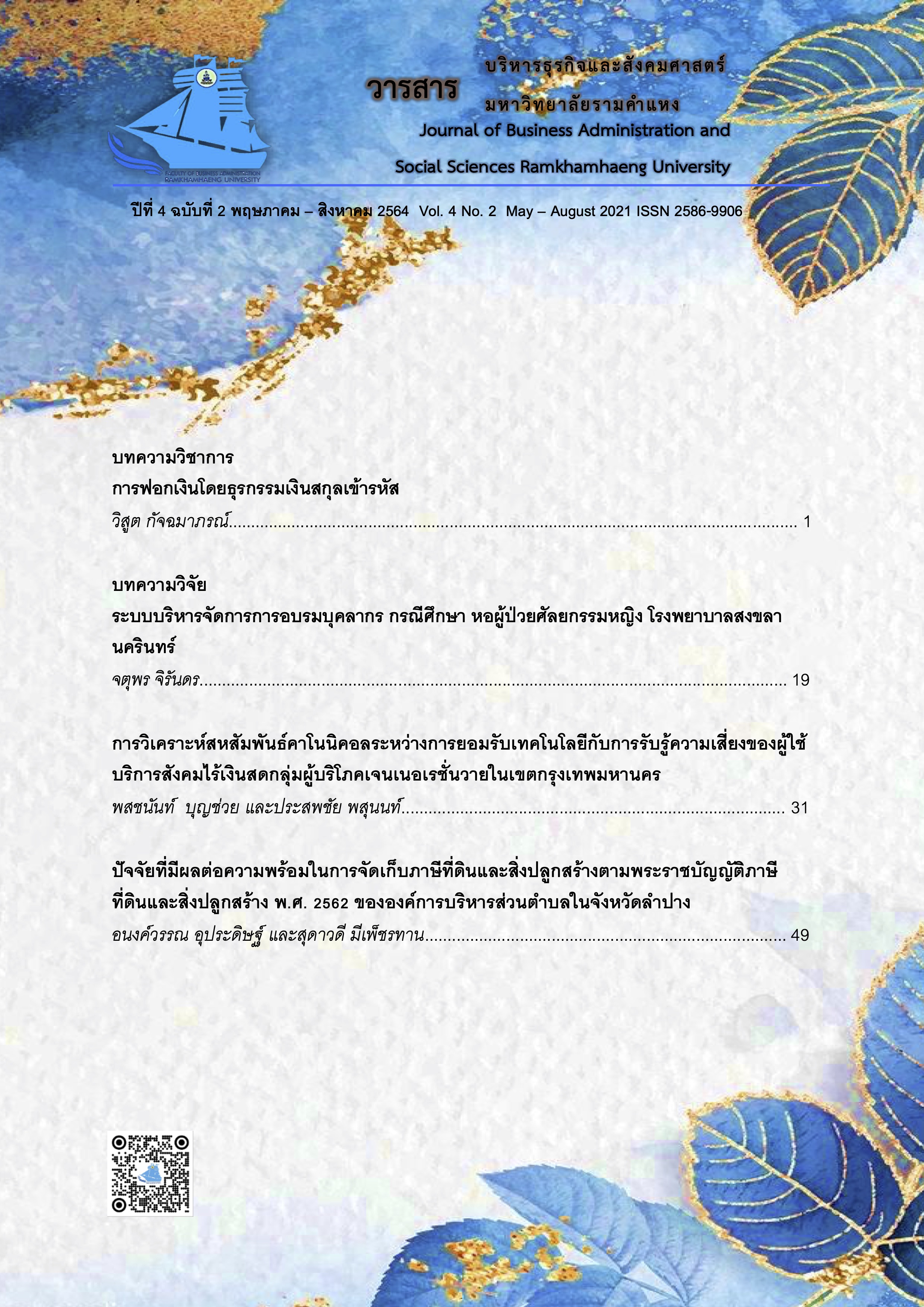Money Laundering by Cryptocurrency Transaction
Main Article Content
Abstract
Money laundering is a process that criminals can use to legitimatize their illegal money and fund crimes. Criminals usually seek for opportunities from modern money laundering tools to avoid rules, regulations, and limitations in laundering their interests. ‘Cryptocurrency’ is a financial innovation that enables users to conduct peer-to-peer transactions globally in a speedy manner without any central controlling agency. It may be used as a tool for money laundering. Crimes with an opportunity to use cryptocurrency as a tool for money laundering are mostly economic crimes or cybercrimes. These crimes usually create wide damages to victims and foster great benefits to criminals. The mechanism of cryptocurrency has the potential to reduce the connection of the transaction path between the source and the destination. It can avoid or be free from being tracked, confiscated, or having the users arrested by officers. Appropriate preventive measures are as follows. Increase the efficiency of user verification by making a national Know Your Customer (KYC) data center. Closely monitor swapping transactions between cryptocurrency and legal currency. Foster skills and knowledge about cryptocurrency correctly to officers and members of the general public. Improve the rules and regulations for the prosecution of cases related to cryptocurrency. Utilize a program to detect suspicious transactions on blockchain technology.
Article Details

This work is licensed under a Creative Commons Attribution-NonCommercial-NoDerivatives 4.0 International License.
เนื้อหาและข้อมูลในบทความที่ลงตีพิมพ์ในวารสารบริหารธุรกิจและสังคมศาสตร์ มหาวิทยาลัยรามคำแหง ถือเป็นข้อคิดเห็นและความรับผิดชอบของผู้เขียนบทความโดยตรง ซึ่งกองบรรณาธิการไม่จำเป็นต้องเห็นด้วย หรือร่วมรับผิดชอบใดๆ
บทความ ข้อมูล เนื้อหา รูปภาพ ฯลฯ ที่ได้รับการตีพิมพ์ในวารสารบริหารธุรกิจและสังคมศาสตร์ มหาวิทยาลัยรามคำแหง ถือเป็นลิขสิทธิ์ของวารสารบริหารธุรกิจและสังคมศาสตร์ มหาวิทยาลัยรามคำแหง หากบุคคลหรือหน่วยงานใดต้องการนำบทความทั้งหมดหรือส่วนหนึ่งส่วนใดไปเผยแพร่ต่อ หรือเพื่อกระทำการใดๆ จะต้องได้รับอนุญาตเป็นลายลักษณ์อักษรจากวารสารบริหารธุรกิจและสังคมศาสตร์ มหาวิทยาลัยรามคำแหง ก่อนเท่านั้น
References
ข่าวการเงิน. (2561, 12 สิงหาคม). เปิด 3 ขั้นตอนโกง “บิตคอยน์” 797 ล้านบาท. กรุงเทพธุรกิจออนไลน์ สืบค้นจาก https://www.bangkokbiznews.com/news/detail/810106
ข่าวอาชญากรรม. (2562, 18 กุมภาพันธ์). ผู้เสียหายร้อง ตำรวจหลังถูกหลอกลงทุน "บิทคอยน์" สูญกว่า 500 ล้าน. ข่าวไทยพีบีเอสออนไลน์. สืบค้นจาก https://news.thaipbs.or.th/content/277818
สำนักงานป้องกันและปราบปรามการฟอกเงิน. (2560). รวมกฎหมายว่าด้วยการป้องกันและปราบปรามการฟอกเงิน และกฎหมายว่าด้วยการป้องกันและปราบปรามการสนับสนุนทางการเงินแก่การก่อการร้าย และการแพร่ขยายอาวุธที่มีอานุภาพทำลายล้างสูง (พิมพ์ครั้งที่ 14). กรุงเทพฯ: แจ็ส เพอ-พริ้น
สำนักงานป้องกันและปราบปรามการฟอกเงิน. (2562). ผลการปฏิบัติงานด้านการป้องกันการฟอกเงิน. (รายงานประจำปี 2562). สืบค้นจาก https://www.amlo.go.th/index.php/th/strategy/annual-report/detail/11092
Baath, D., & Zellhorn, F. (2016). How to combat money laundering in Bitcoin? – An institutional and game theoretic approach to anti-money laundering prevention measures aimed at Bitcoin. Institutioen for Ekonomisk och Industriell Utveckling (IEI), Linkopings Universitet, Retrieved from https://www.diva-portal.org/smash/get/diva2:1039181/FULLTEXT01.pdf
Burniske, C., & Tara, J. (2017). Cryptoassets: The Innovative Investor's Guide to Bitcoin and Beyond: McGraw-Hill.
Chainalysis. (2021). The 2021 Crypto Crime Report; Everytheing yoi need to know about ransome, darknet markets and more. Retrieved from https://go.chainalysis.com/2021-Crypto-Crime-Report.html
Choo, K. K. R. (2015). Cryptocurrency and virtual currency: Corruption and money laundering/terrorism financing risks?. In Handbook of digital currency (pp. 283-307). Academic Press.
Dyntu, V., & Dykyi, O. (2019). Cryptocurrency in the System of Money Laundering. Baltic Journal of Economic Studies, 4(5). doi:10.30525/2256-0742/2018-4-5-75-81
Edwin H. Sutherland, (1961). White Collar Crime, New York: Holt, Rinehart and Winston, p. 9-10.
European Commission. (2020). Money Laundering, An official website of the European Union, Organised Crime and Human Trafficking. Retrieved from https://ec.europa.eu/home-affairs/what-we-do/policies/organized-crime-and-human-trafficking/money-laundering_en#:~:text=Money%20laundering%20is%20the%20process,beings%20as%20well%20as%20fraud.
Fanusie, Y. J., & Robinson, T. (2018). Bitcoin Laundering : An Analysis of Illicit Flows into Digital Currency Services. Center of Sanctions & Illictic Finance and ELLIPTIC. Retrieved from https://www.fdd.org/wp-content/uploads/2018/01/MEMO_Bitcoin_Laundering.pdf
Financial Action Task Froce (FATF). (2019). Financial Action Task Froce – 30 years. Retrieved from www.fatf-gafi.org/publications/fatfgeneraldocuments/FATF-30.html
Girasa, R. (2018). Regulation of cryptocurrencies and blockchain technologies: national and international perspectives. Springer.
Homeland Security Enterprise. (2014). Risk and Threats of Cryptocurrencies. Homeland Security Studies and Analysis Institute (HSSAI),. Retrieved from https://www.anser.org/docs/ reports/RP14-01.03.03-02_Cryptocurrencies%20508_31Dec2014.pdf
Houben, R., & Snyers, A. (2018). Cryptocurrencies and blockchain. Legal context and implications for financial crime, money laundering and tax evasion.. Policy Department for Economic, Scientific and Qualities of Life Policies: European Parliament. Retrieved from http://www.europarl.europea.eu/supporting-analysis
Jacquez, T. (2016). Cryptocurrency the New Money Laundering Problem for Banking, Law Enforcement, and the Legal System. ProQuest Dissertations Publishing. (Master of Science in Cybersecurity). Retrieved from https://search.proquest.com/openview/ daa0d91607166b4d9e3a0accbca6cc09/1?pq-origsite=gscholar&cbl=18750&diss=y
Kepli, M. Y. b. Z., & Zulhuda, S. (2019). Cryptocurrencies and Anti-money Laundering Laws: The Need for an Integrated Approach. In Emerging Issues in Islamic Finance Law and Practice in Malaysia (pp. 247-263).
Kethineni, S., & Cao, Y. (2019). The Rise in Popularity of Cryptocurrency and Associated Criminal Activity. International Criminal Justice Review, 30(3), 325-344. doi:10.1177/10575 67719827051
Lilly, J. R., Cullen, F. T., & Ball, R. A. (2015). Criminological Theory : Context and Consequences (6th ed.) SAGE Publication Inc.
Nakamoto, S. (2008). Bitcoin : A Peer-to-Peer Electronic Cash System. Decentralized Business Review, 21260. Retrieved from https://s3.amazonaws.com/academia.edu.documents /32413652/BitCoin_P2P_electronic_cash_system.pdf?AWSAccessKeyId=AKIAIWOWYYGZ2Y53UL3A&Expires=1543487245&Signature=vgVx%2BPi%2FU%2Bb3ku%2BPJY%2BKqUCw8%2FE%3D&response-content-disposition=inline%3B%20filename%3DBitcoin_A_Peer-to-Peer_Electronic_Cash_S.pdf
Samanta, S., Mohanta, B. K., Pati, S. P., & Jena, D. (2019). A Framework to Build User Profile on Cryptocurrency Data for Detection of Money Laundering Activities. Paper presented at the 2019 International Conference on Information Technology (ICIT), Bhubaneswar, India, India. Retrieved from https://ieeexplore.ieee.org/document/9031941
Siegel, L. J. (2013). Criminology: Theories, Patterns and Typologies (11th ed.) Linda Ganster.
The Law Library of Congress. (2018). Regulations of Cryptocurrency Around the world. Global Legal Research Center,. Retrieved from https://www.loc.gov/law/help/cryptocurrency/ cryptocurrency-world-survey.pdf
The Reporter Asia Online. (2020). ตามรอย โรงพยาบาลสระบุรี โดน Ransomware เรียกค่าไถ่. Retrieved from https://www.thereporter.asia/th/2020/09/10/ransomware-hospital/
Unite Nations Office on Drugs and Crime. (2020). The Money Laundering Cycle. Retrieved from https://www.unodc.org/unodc/en/money-laundering/laundrycycle.html


